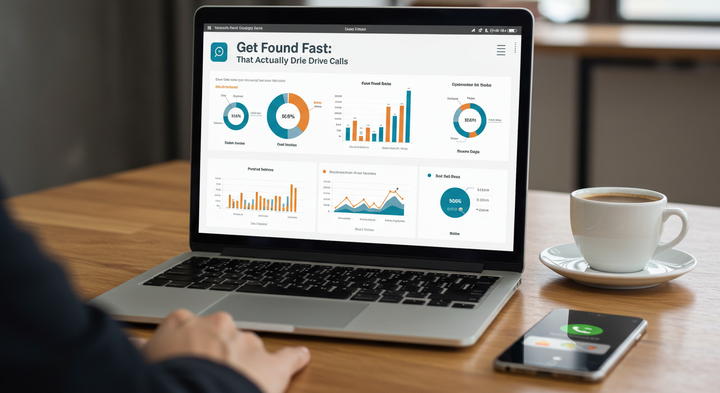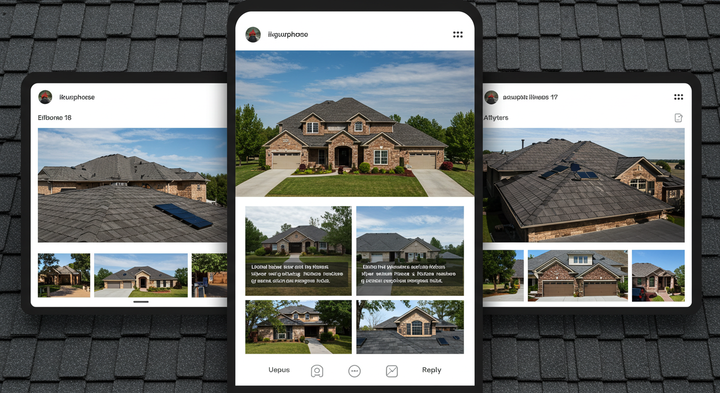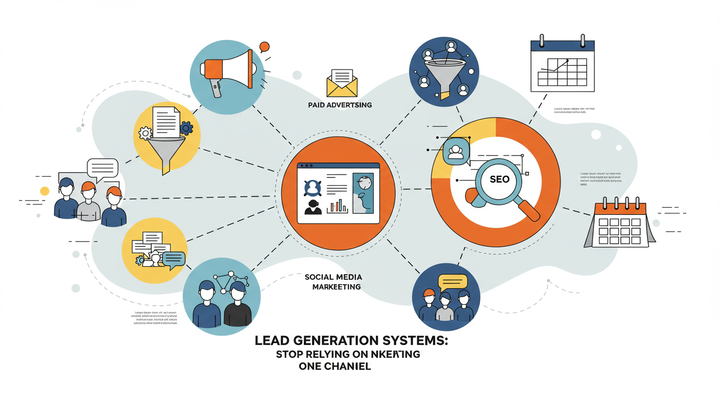If you’re still running your roofing business with 2020 marketing tactics—word-of-mouth, cold calls, generic Facebook posts—you’re not just behind. You’re invisible to today’s buyer.
In 2025, homeowners don’t scroll through listings or ask around. They search, scan, and decide. And they do it fast. Within seconds, they’ll either call a roofer—or move on. So the question is: are they finding you first, and do they trust what they see when they do?
This isn’t about gimmicks. The top roofing companies this year aren’t spamming neighborhoods or chasing leads. They’re showing up at the top of Google. They’re trusted before they ever answer the phone. And they’re booking consistent jobs with exclusive, inbound leads—the kind that don’t waste time or ask for ten quotes.
This guide breaks down what’s actually working now—real strategies, not fluff. Whether you’re trying to stop relying on referrals, fix an underperforming ad budget, or finally grow with confidence, you’ll find answers here.
From SEO and content to paid ads, video, and automation—we’ll walk you through how to turn your marketing from a money pit into a system that drives revenue, month after month.
A roofer’s website used to be a nice-to-have. In 2025, it’s non-negotiable. Not because people care about fancy design—but because your site now acts as your virtual estimator, receptionist, and trust builder all in one.
If a homeowner finds you online and lands on a clunky page that doesn’t answer three core questions—what do you do, where do you work, and how can I contact you—they’re gone in seconds.
Here’s how to make sure your site pulls its weight.
Your homepage and key service pages need to drive action, not just look good. That means:
Think of your site like a conversation: each section answers a question and moves the lead one step closer to booking.
With over 70% of site traffic coming from mobile in 2025, your site needs to be built for thumb-scrollers, not desktop browsers.
Core essentials:
Don’t overthink it—just make it fast, clear, and easy to use on any device.
The average homeowner is skeptical until proven otherwise. Before they even read your “About” section, they need to feel like you’re credible.
That means:
We’re not selling trust—we’re showing it.
Your site’s most important job? Making it ridiculously easy to reach you.
This isn’t the place for clever forms or quirky designs. Stick to what works:
You don’t need a chatbot or automation tool to convert—you just need zero friction between interest and action.
When you get this part right, your marketing starts compounding.
Every dollar you spend on traffic—SEO, ads, social—becomes way more effective because the destination is built to convert.

Most roofing businesses think “being on Google” means having a website and hoping someone stumbles across it. But in 2025, real visibility means owning your local area across multiple touchpoints: Maps, organic listings, reputation, and even voice search.
It’s not about ranking #1—it’s about showing up everywhere your customer looks and being the most trusted option when they do.
Here’s how the roofing pros are doing it in 2025:
Your Google Business Profile (GBP) is the single most important asset for local SEO. It’s the first thing people see when they search “roof repair near me”—and it’s often the only thing they’ll check before deciding to call.
2025 strategies that actually move the needle:
Bonus tip: Add a few short videos to your GBP gallery. It’s a visibility hack most roofers still aren’t using—and it makes you look 10x more legit.
If you serve multiple cities or suburbs, you need individual landing pages for each location—and they can’t all say the same thing.
Instead of generic “Roofing in [City]” pages, give each one:
These pages not only rank better—they convert better, too.
It’s not just about how many reviews you have—it’s about how recently they were posted.
Google and customers both trust fresh reviews more than 100+ that are years old. You need a system that gets a steady stream of 5-star ratings every month.
What works in 2025:
Pro tip: Add a few reviews to your site’s homepage or service pages—especially ones with keywords like “roof repair,” “fast quote,” or “[Your City].” They help with rankings and conversions.
More than ever, people are using voice commands to find help fast:
“Hey Google, who’s the best roofing contractor near me?”
That means your content needs to sound natural and answer direct questions:
These can be built into your FAQs, blog posts, and even location pages. It’s not about keyword stuffing—it’s about conversational answers that match what real people ask.
Local SEO isn’t something you check off. It’s something you work—weekly. And when done right, it doesn’t just boost rankings. It fills your calendar with qualified leads who trust you before they even call.
If Google Ads has burned you in the past, you’re not alone. Most roofing companies either give up after wasting budget—or hand it off to a generic agency that promises leads but delivers clicks that go nowhere.
But here’s the truth: in 2025, Google Ads still works—brilliantly—if you use the right strategy. That means no broad-match guessing, no generic landing pages, and absolutely no “set it and forget it” campaigns.
Here’s what separates the winners from the wasters:
Forget trying to rank for “roofing” or “roofing services.” That’s how you get clicks from people who are still browsing—or worse, looking for a job.
In 2025, smart campaigns are laser-focused on bottom-of-funnel keywords like:
Pair those with exact match and phrase match targeting—not broad match—and you’ll stop wasting money on junk traffic.
One of the biggest mistakes? Sending ad traffic to your homepage. In 2025, every ad should point to a page built for one job only: conversion.
What a high-performing roofing landing page includes:
Bonus: Add urgency—“Appointments available this week” or “Next-day service in [suburb]” works great for roofing.
If you’re not running Google LSAs yet, you’re missing easy wins. These show up above search ads and organic listings—with your photo, reviews, and “Google Guaranteed” badge.
Why they work in 2025:
Just make sure you set your business categories correctly, upload solid job photos, and keep reviews flowing in. It’s one of the best lead channels for roofers right now.
If your current agency can’t show you which keywords turned into phone calls, they’re flying blind—and so are you.
What you need:
Because in 2025, roofing businesses don’t just want leads—they want the right leads. And you can’t scale what you don’t measure.
The last piece of the puzzle? Protect your budget.
Smart roofing campaigns:
You’re not here for impressions. You’re here for qualified leads who want a quote, now.
When done right, Google Ads turns from being an expense into a predictable pipeline. You know what you’ll spend, what you’ll get, and when the phone will ring. That’s how modern roofers scale.

Social media still gets treated like an afterthought in most roofing businesses—if it’s even used at all. But in 2025, it’s a fast-moving channel for building trust, showing proof, and staying top-of-mind with local homeowners.
It’s not about chasing trends. It’s about staying visible, staying credible, and staying booked.
No one cares if your post gets a million views if the people watching live four states away. The goal here is to build recognition and familiarity in your service area.
What’s working:
This kind of content sticks. It builds familiarity—and when it’s time to hire, they’re already sold on you.
Don’t try to be everywhere. Pick two platforms max and own them.
By focusing your efforts, you stay consistent—and consistency beats randomness every time.
A $30 post boost can sometimes outperform a $300 ad if the content resonates.
Best-performing content to promote:
Just remember: boost posts that already got likes, saves, or shares. That early signal tells the algorithm it’s worth showing to more people.
Social platforms—especially Facebook—double as search engines. When someone searches your name, what they see matters.
Quick wins:
Your presence should feel active, trustworthy, and local. Not like it was last touched in 2022.
The goal of social media in 2025 isn’t to go viral. It’s to show up when people are watching, so they remember you when they’re ready. And when they are, you’ve already built trust before they’ve even dialed your number.
Most roofing companies treat content like a box to check—upload a blog every month, post a few before-and-after photos, and call it a day.
But the smartest roofing brands in 2025 are doing something different. They’re creating intent-driven content that brings in organic leads, answers buyer questions before they’re asked, and keeps them top-of-mind even when customers aren’t ready to buy yet.
Here’s how to make your content actually work for you.
You don’t need 100 blog posts—you need the right blog posts.
Start with:
These types of posts:
Pro tip: Use real job photos in your posts. Google loves it, and so do homeowners.
Video content is crushing in 2025. Not because it’s trendy—but because it creates trust faster than text ever will.
Best-performing videos:
Where to post:
Video doesn’t have to be polished. It just has to be clear, honest, and helpful.
Want to stand out from other roofers who only post “Happy Friday!” memes? Give your leads something they can use—and that makes you look like the expert.
Examples:
Add a download button. Gate it with a form if you want. Or don’t. Either way, this kind of content positions your company as the one who actually knows what they’re doing.
Good content doesn’t just educate. It closes gaps, builds confidence, and brings in leads who already trust you by the time they call.

Most roofers start with one lead source—Google, Facebook, maybe referrals—and ride it until it stalls. But in 2025, serious roofing companies aren’t just relying on a channel. They’re building systems—layered strategies that bring in leads from multiple touchpoints and never depend on just one algorithm or platform.
Here’s how the most consistent roofing companies are generating leads on autopilot:
The real power isn’t in SEO or ads alone—it’s in how they work together.
Example of a winning system:
The best lead funnels blend:
It’s not about picking a favorite—it’s about building a flywheel.
In 2025, leads that aren’t followed up within 5–10 minutes often go cold. And no busy roofing team has time to chase every contact form.
That’s where a simple CRM (Customer Relationship Management tool) with automation comes in.
What it can do:
Top tools for roofers:
Automation doesn’t replace you—it supports your crew and stops leads from slipping away.
Referrals are gold—but they don’t happen by accident.
2025 lead systems include trackable referral flows, not just “Tell your friends.”
How to do it right:
Better yet? Use a link generator or code-based system so clients can easily send people your way.
Running a spring ad or SEO sprint might bring a bump. But serious growth comes from building a pipeline that runs day in, day out.
That pipeline should:
You’re not guessing. You’re running a system that feeds your calendar every single week.
Ask most roofers how often they email past customers and you’ll get the same answer: “Never.” Which is wild—because in 2025, the smartest roofing businesses are using email to stay booked without spending a cent on ads.
Why? Because email is personal. It’s low-cost. And it works.
Here’s how to build a simple email system that keeps your calendar full and your brand front of mind.
Every customer you work with should be added to a segmented, permission-based email list. The same goes for every lead—whether they booked or not.
How to build that list:
Don’t overthink it—just start collecting. A list of 100 good contacts is worth more than 1,000 random followers.
All customers are not the same. A homeowner who got a new roof last year isn’t interested in the same message as someone who hasn’t booked yet.
At a minimum, segment into:
Then, tailor your messages. For example:
2025 homeowners are used to junk email. So if you’re going to show up in their inbox, make it count.
Email ideas that work:
Always include:
You don’t need fancy design. Just clear, helpful, short-form emails—2 to 3 paragraphs max.
Email automation isn’t just for big brands. Every roofer should have at least 3 automations running:
Tools like GoHighLevel, Mailchimp, and ActiveCampaign make this easy.
Use merge fields and short sentences to keep it human.
A good email list becomes a lead machine that works silently in the background. It turns happy customers into repeat buyers, referrals, and five-star reviewers—without paying for another click.

You can’t grow what you don’t measure. And in roofing, guessing at your marketing ROI is how you end up with a big ad bill and an empty calendar.
In 2025, the best roofing companies are tracking every lead source, every call, and every dollar spent—because they know the difference between traffic and revenue.
Here’s how to measure what matters.
This might sound obvious, but it’s a common trap: someone says “We got 100 leads this month!”—but no one asks how many of those became booked jobs.
So here’s the split you need to track:
Once you start separating traffic from actual dollars, you’ll know which channels deserve your budget—and which ones are just noise.
Yes, it’s important to know how much a lead costs. But it’s more important to know how much that lead is worth.
Let’s say you spend $250 to get a lead from Google Ads. That might sound high—until you realize:
Suddenly, that $250 lead brought in over $10,000. That’s why LTV always matters more than CPL.
Here’s your short list of numbers to monitor monthly:
Tools like CallRail, WhatConverts, or your CRM dashboard can help automate this.
You don’t need to track 50 metrics. Just track the ones that tell you:
“What’s bringing in jobs, and what’s not?”
Imagine a crew that doesn’t show up, costs more than expected, and never finishes jobs. You’d let them go, right?
Now think about your:
If you’re not tracking whether those “crew members” are doing their job, you might be pouring budget into dead weight.
Treat your marketing spend the same way you’d treat payroll: accountable, tracked, and tied to results.
Knowing your numbers turns marketing from a gamble into a growth engine. It tells you where to double down, when to pause, and how to scale without the guesswork.
If you’ve been burned by a marketing agency before, you’re not alone.
Most roofing business owners have tried at least one agency that promised “more leads” and delivered nothing but traffic, vague reports, and zero real bookings. That’s not bad luck—it’s the result of working with teams that don’t understand roofing, local lead gen, or how high-ticket home services really work.
So how do you choose a partner who actually helps you grow?
Marketing a roofing company isn’t the same as marketing a restaurant or an e-commerce brand. It’s local, service-based, trust-driven, and deeply tied to seasonal cycles.
Here’s how to spot a generic agency:
You don’t need theory—you need a proven system that brings in calls, books inspections, and feeds your calendar.
Before you sign with any agency, ask:
If they hesitate, dodge, or can’t give you clear answers? That’s your answer.
Any agency can run ads or post on Facebook. The ones worth hiring will ask deeper questions:
They’ll bring strategy, not just deliverables. Because great marketing doesn’t just make noise—it solves bottlenecks and fuels growth.
We built our agency specifically for roofing and solar businesses—because we saw too many good companies wasting money on generic strategies that don’t work in this space.
What we focus on:
Our clients don’t chase leads. They attract them. And we help them build systems that scale—not stress.
Choosing the right partner can be the difference between staying stuck—or scaling past 7 figures with confidence. The Roofing Marketer helps roofing businesses own their market and build growth that lasts.
Most roofing companies don’t fail because of the work—they fail because they never built a marketing engine. One that runs when they’re busy. One that brings in the right kind of leads, at the right time, in the right service areas.
By now, you’ve seen what that looks like:
This guide gave you the blueprint. But if you’d rather skip the trial and error and plug into a team that already knows the roofing game inside and out—we’ve got you.
The Roofing Marketer builds high-converting, fully trackable, exclusive lead systems for roofers who are ready to scale.
Let’s book a strategy call and map it out together.

Marketing ambassadors of Solar and Roofing Industry. Ready to take your Roofing business to the moon?